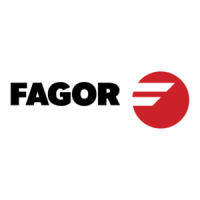Programming manual
CNC 8055
CNC 8055i
PROGRAM CONTROL INSTRUCTIONS
14.
·M· & ·EN· MODELS
SOFT: V02.2X
·409·
Program instructions
Parameter A/D is used when the program to be edited already exists.
A The CNC appends the new blocks after the ones already existing.
D The CNC deletes the existing program and starts editing a new one.
A program comment may also be associated with it; this comment will later be displayed next to it
in the program directory.
To edit blocks, the WRITE instruction must be used as described next.
Notes:
If the program to be edited already exists and the A/D parameters are not defined, the CNC will
display an error message when executing the block.
The program opened with the OPEN instruction is closed when executing an M30, or another
OPEN instruction and after an Emergency or Reset.
From a PC, only programs stored in the CNC'S RAM memory, or in the hard disk (KeyCF) can
be opened
( WRITE <block text> )
The mnemonic WRITE adds, after the last block of the program which began to be edited by means
of the mnemonic OPEN P, the information contained in <block text> as a new program block.
When it is an ISO coded parametric block, all the parameters (global and local) are replaced by the
numeric value they have at the time.
(WRITE G1 XP100 YP101 F100) => G1 X10 Y20 F100
When it is a parametric block edited in high level, use the "?" character to indicate that the parameter
is supposed to be replaced by the numeric value it has at the time.
If the mnemonic WRITE is programmed without having programmed the mnemonic OPEN
previously, the CNC will display the corresponding error, except when editing a user customized
program, in which case a new block is added to the program being edited.
Using the character "$" in the WRITE instruction to write the number of a parameter:
While using the character "$" in the WRITE instruction, it will be possible to write the parameter
number directly. For that, use the "$" character followed by "P" as long is it is preceded by an axis.
For example, programming (WRITE X$P100) the result will be: XP100.
To show something in $, the value must be programmed after the $ sign. But, to take the value from
a parameter, put a space between the "$" sign and the parameter.
In short, these are the options:
• When programmed $P, it will output $P.
• When programmed $[space]P, it will output $[space] and the content of P.
• When programmed $[number], it will output $[number].
Example:
Being parameter P100=22.
Program Result
(WRITE XP100) X22
(WRITE X$P100) XP100
(WRITE $ P100) $ 22
(WRITE $3000) $3000
(WRITE (SUB P102))
(WRITE (SUB ?P102))
(WRITE (ORGX54=P103))
(WRITE (ORGX54=?P103))
(WRITE (PCALL P104))
(WRITE (PCALL ?P104))
=>
=>
=>
=>
=>
=>
(SUB P102)
(SUB 55)
(ORGX54=P103)
(ORGX54=222)
(PCALL P104)
(PCALL 25)

